Analysis of the Operation and Financial Condition of the Enterprise
Analysis of the Operation and Financial Condition of the Enterprise
Analysis of the Operation and Financial Condition of the Enterprise
Create successful ePaper yourself
Turn your PDF publications into a flip-book with our unique Google optimized e-Paper software.
<strong>Analysis</strong> <strong>of</strong> <strong>the</strong> <strong>Operation</strong> <strong>and</strong> <strong>Financial</strong> <strong>Condition</strong> <strong>of</strong> <strong>the</strong> <strong>Enterprise</strong>Taxation payable is <strong>the</strong> estimated, yet unpaid tax amounts (tax liabilities, forexample, <strong>the</strong> social insurance tax, individual income tax estimated from <strong>the</strong> salaries <strong>of</strong>employees etc.).Dividends payable are <strong>the</strong> accrued dividends on <strong>the</strong> capital invested to <strong>the</strong>shareholders that are not paid yet due to various reasons (shortage <strong>of</strong> free cash etc.).Salaries payable are <strong>the</strong> salaries, premium etc. payments that have not yet beendisbursed by an enterprise to its employees.Long-term liabilities are liabilities which are not repayable within <strong>the</strong> year <strong>of</strong>taxation <strong>and</strong> <strong>the</strong> term <strong>of</strong> repayment would be more than one year.Long-term liabilities are as follows: long-term bank loans; o<strong>the</strong>r long-term loans <strong>and</strong> credit facilities.Long-term bank loans <strong>and</strong> credit facilities are liabilities incurred upon borrowing <strong>of</strong>capital from a lender – <strong>the</strong> creditor, for a longer period <strong>of</strong> time (above one year) <strong>and</strong> payinginterest on <strong>the</strong> credit borrowed in accordance with <strong>the</strong> loan or credit agreement.O<strong>the</strong>r long-term liabilities can incur from debts <strong>of</strong> an enterprise or liabilities underleasing contracts for equipment or buildings etc.Equity capital as balance sheet liability element consists <strong>of</strong> <strong>the</strong> following mainitems: equity capital (share capital); reserve capital; retained earnings for <strong>the</strong> reporting year; retained earnings from previous periods.Equity capital or stock capital, or share capital is <strong>the</strong> capital invested by <strong>the</strong> ownersmade up <strong>of</strong> investments by <strong>the</strong> participants or shareholders, <strong>the</strong> amount <strong>of</strong> which isstipulated in <strong>the</strong> enterprise articles <strong>of</strong> association. Share capital is disclosed in <strong>the</strong>balance sheet at <strong>the</strong> nominal value <strong>of</strong> shares.Investments by <strong>the</strong> enterprise participants can be in <strong>the</strong> form <strong>of</strong> both cashinvestments <strong>and</strong> property investments, for example, by investing production equipmentitems or entire production facilities.Additional capital is <strong>the</strong> increase in <strong>the</strong> book value <strong>of</strong> <strong>the</strong> share capital occurring asa result <strong>of</strong> a new share issue. Assets acquired by an enterprise as a result <strong>of</strong> shares’ saleare <strong>the</strong> additional capital <strong>of</strong> an enterprise. Besides, <strong>the</strong> equity capital may be increasedalso on <strong>the</strong> account <strong>of</strong> <strong>the</strong> proceeds from <strong>the</strong> issue (share premium) acquired on <strong>the</strong>account <strong>of</strong> <strong>the</strong> difference between <strong>the</strong> nominal value <strong>and</strong> <strong>the</strong> actual sales value <strong>of</strong> <strong>the</strong>shares.A source <strong>of</strong> <strong>the</strong> enterprise additional capital can be also disposal <strong>of</strong> a share <strong>of</strong>enterprise assets at prices exceeding <strong>the</strong>ir book value or at a price below <strong>the</strong> book value.Retained earnings are a component part <strong>of</strong> <strong>the</strong> capital <strong>of</strong> an enterprise which hasbeen accumulated from <strong>the</strong> net income <strong>of</strong> <strong>the</strong> previous years after <strong>the</strong> deduction <strong>of</strong>dividends to shareholders or owners. Retained earnings may appear in <strong>the</strong> balance sheetliabilities as <strong>the</strong> retained earnings from previous years, <strong>the</strong> reserve capital or net incomefor <strong>the</strong> reporting year (income as per <strong>the</strong> balance sheet less tax).The items <strong>of</strong> retained earnings reflect <strong>the</strong> increase in <strong>the</strong> capital invested.53
















